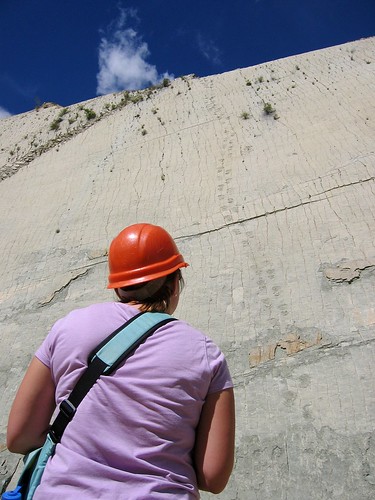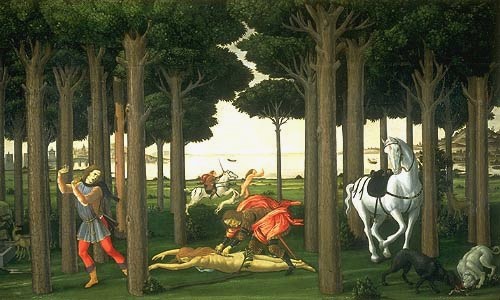
This moving billboard, placed at Downtown Madrid area, reminds me of the old Camel smoking billboard which kept puffing over Broadway until 1966, but this time the movement comes from the wheels of the car in the advertisement. These four wheels keep turning night and day, generating a realistic sensation of movement. Just have a look:
Brilliant mechanical billboard in Madrid (Spain)
Escrito por Aberrón en 7:20 PM | 1 comentarios»
Imagine a wall with more than 5,000 dinosaur tracks: they call it the dinosaurs dancefloor
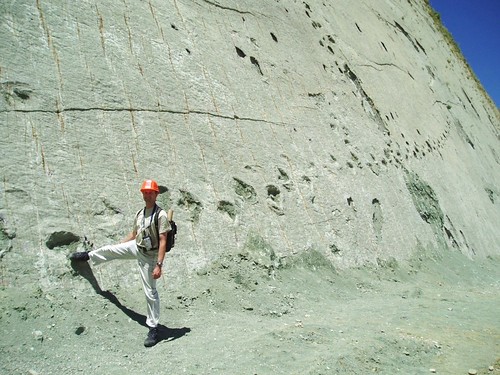 Image: Yatlik.com
Image: Yatlik.com
The immense Bolivian site (Cal Orko) is the rock face of an outcropping on a slant of 73 degrees, 80 meters high and 1.2 km long. There are more than 5,000 tracks of 294 different dinosaurs made during the second half of the Cretaceous period.
There is such an impressive amount of tracks that some of the researchers said this place seemed to be a dinosaurs’ dancefloor.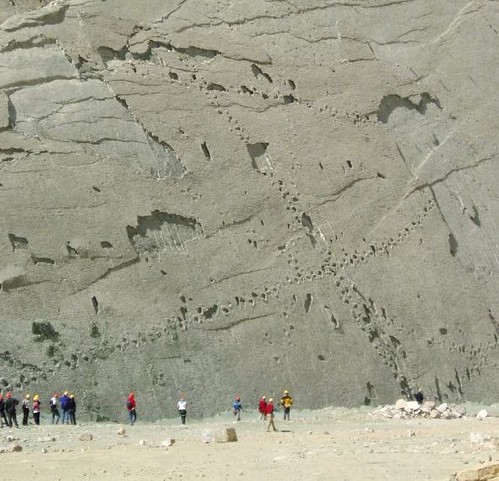 Image: Jpspbj (Flickr)
Image: Jpspbj (Flickr)
According to dinosaurus.org, the tracklevel dates from the Late Cretaceous and forms part of the El Molino Formation, the estimated age is about 68 million years. More than 250 trackways have been registered and six different types of dinosaurs have been present. The most spectacular trackways are those of quadrupedal titanosaurs, herbivore animals with a size between 15 and 25m.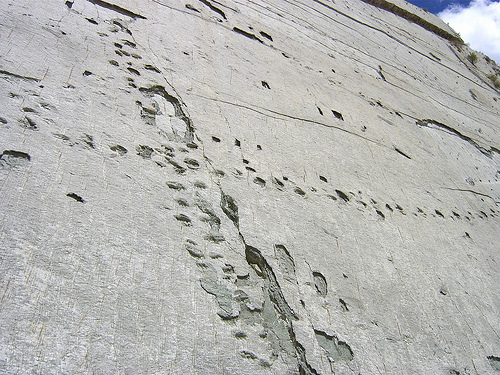 Image: Rikkiandmatt (Flickr)
Image: Rikkiandmatt (Flickr)
Perhaps, the most special track is a 347 meters footpath, the longest dinosaur trackway ever known, made by a baby Tyrannosaurus rex nicknamed “Johnny Wallker” by researchers. Image: Ryan Greenberg (Flickr)
Image: Ryan Greenberg (Flickr)
During the Cretaceous, Cal Orko was part of an immense shallow lake. In the Tertiary, when the Andes Mountains were formed, the movement of the tectonic plates pushed the former lake bed vertically. Not far from this site, eight others have been found in recent years and are currently being studied. Image: Ramón Arellano (Flickr)
Image: Ramón Arellano (Flickr)
According to Christian Meyer, the discovery is an enormous contribution to humanity and to science, revealing data heretofore unknown and "documenting the high diversity of dinosaurs better than any other site in the world".
To contribute to preserving the site, a Cretaceous Park is open since March 2006. In this park, replicas of different dinosaur species welcome visitors to a museum with audiovisual exhibits, transporting their minds to prehistoric time. Image: Flyingtiti (Picasa)
Image: Flyingtiti (Picasa)
More info: 1, 2, 3
References: Las huellas de Cal Orcko (duiops.net) / Los saurios de Sucre (Artículo de la revista BDW, sept 2001) / Parque Cretácico (web oficial) / Cal Orko (Wikipedia)
Escrito por Aberrón en 4:49 AM | 21 comentarios»
Imagine all human figures vanishing from painting masterpieces


Imagine, for example, The Garden of Earthly Delights (the famous triptych by Hieronymus Bosch) without any people. Or Fra Angelico's Annunciation with no Virgin and no angel on the scene. These are some of the ‘hacks’ at Ballester’s current exhibition Espacios Ocultos.
According to his official site, Ballester's work seeks to "purge all human anecdotes" from historical landscape painting and invert the hierarchy, giving priority to traditionally considered “background”.
Honestly, I don’t mind what the artist is seeking with his work. I just love those frightening landscapes!
All Images © José Manuel Ballester
Current Exhibition: Galería Distrito Cu4tro (Madrid) / [Via: EPS]
See also: Famous painters copied photographs (Fogonazos)
Escrito por Aberrón en 3:14 PM | 0 comentarios»
Escalando el gran colmillo de hielo
 Situado en el corazón de las Montañas Rocosas, el Colmillo de Vail, en Colorado, puede alcanzar los 50 metros de altura y hasta ocho metros de grosor. Curiosamente, este gigantesco pilar de hielo no se forma todos los inviernos, sino sólo en aquéllos lo suficientemente crudos como para congelar las cascadas que recorren la montaña. Es entonces cuando el colmillo se convierte en un santuario para los amantes del riesgo.
Situado en el corazón de las Montañas Rocosas, el Colmillo de Vail, en Colorado, puede alcanzar los 50 metros de altura y hasta ocho metros de grosor. Curiosamente, este gigantesco pilar de hielo no se forma todos los inviernos, sino sólo en aquéllos lo suficientemente crudos como para congelar las cascadas que recorren la montaña. Es entonces cuando el colmillo se convierte en un santuario para los amantes del riesgo. Tal y como advierten los expertos, escalar por esta torre de hielo puede convertirse en una aventura demasiado peligrosa. Si la temperatura empieza a aumentar o han pasado demasiados escaladores en los días anteriores - dejando los correspondientes agujeros que debilitan la estructura - el hielo puede empezar a fallar y provocar una caída fatal.
Tal y como advierten los expertos, escalar por esta torre de hielo puede convertirse en una aventura demasiado peligrosa. Si la temperatura empieza a aumentar o han pasado demasiados escaladores en los días anteriores - dejando los correspondientes agujeros que debilitan la estructura - el hielo puede empezar a fallar y provocar una caída fatal. Escrito por Aberrón en 4:37 PM | 2 comentarios»
El mayor espejo natural del mundo
 Situado en el altiplano de Bolivia, el Salar de Uyuni no solo es el mayor desierto de sal del mundo sino que constituye un gigantesco espejo natural. Durante la estación húmeda, las lluvias dejan una finísima capa de agua sobre la llanura, lo que provoca uno de los espectáculos naturales más hermosos de la Tierra.
Situado en el altiplano de Bolivia, el Salar de Uyuni no solo es el mayor desierto de sal del mundo sino que constituye un gigantesco espejo natural. Durante la estación húmeda, las lluvias dejan una finísima capa de agua sobre la llanura, lo que provoca uno de los espectáculos naturales más hermosos de la Tierra.La superficie de este desierto se extiende a lo largo de 12.000 kilómetros cuadrados, un área equivalente a la provincia de Guadalajara, y alberga alrededor de 64.000 millones de toneladas de sal. La incidencia de la luz sobre la superficie mojada provoca la sensación de estar caminando sobre el cielo. (Seguir leyendo) (English)
Escrito por Aberrón en 4:10 PM | 1 comentarios»
El hombre de hielo
 Este hombre que corre desnudo por la nieve se llama Wim Hof. La temperatura exterior es de 15 grados bajo cero. Lleva corriendo más de una hora a escasos kilómetros del círculo polar y, aunque sus pies descalzos se apoyan directamente sobre el hielo, no muestra ningún síntoma de hipotermia. (Seguir leyendo) (English)
Este hombre que corre desnudo por la nieve se llama Wim Hof. La temperatura exterior es de 15 grados bajo cero. Lleva corriendo más de una hora a escasos kilómetros del círculo polar y, aunque sus pies descalzos se apoyan directamente sobre el hielo, no muestra ningún síntoma de hipotermia. (Seguir leyendo) (English) Escrito por Aberrón en 4:00 PM | 0 comentarios»
Rastros en la noche
 Esta composición de 70 exposiciones, tomadas cerca de la puesta de sol el 7 de febrero, mirando al norte, muestra el rastro de la ISS (con interrupciones entre exposiciones) mientras se movía de derecha a izquierda sobre la ciudad de Tubinga en el sur de Alemania. Más en observatorio.info
Esta composición de 70 exposiciones, tomadas cerca de la puesta de sol el 7 de febrero, mirando al norte, muestra el rastro de la ISS (con interrupciones entre exposiciones) mientras se movía de derecha a izquierda sobre la ciudad de Tubinga en el sur de Alemania. Más en observatorio.info
Escrito por Aberrón en 3:42 PM | 0 comentarios»
Kolmanskop, la ciudad devorada por la arena
 En el año 1908, atraídos por el hallazgo de diamantes en la zona, los alemanes establecieron una mina en la desértica región del Namib y fundaron la pequeña ciudad de Kolmanskop. La prosperidad de la mina hizo que la ciudad fuera creciendo en tamaño y que sus habitantes construyeran suntuosas mansiones, un salón de baile y hasta un hospital. Pero después de la Gran Guerra los diamantes empezaron a escasear y los alemanes hicieron las maletas.
En el año 1908, atraídos por el hallazgo de diamantes en la zona, los alemanes establecieron una mina en la desértica región del Namib y fundaron la pequeña ciudad de Kolmanskop. La prosperidad de la mina hizo que la ciudad fuera creciendo en tamaño y que sus habitantes construyeran suntuosas mansiones, un salón de baile y hasta un hospital. Pero después de la Gran Guerra los diamantes empezaron a escasear y los alemanes hicieron las maletas. El aspecto de la actual Kolmanskop es el de una ciudad devorada por la arena. El desierto ha ido penetrando en el interior de las mansiones a través de puertas y ventanas, convirtiendo los elegantes recibidores en el refugio de misteriosas dunas y sembrando de inesperadas playas los salones. (Seguir leyendo) (English)
El aspecto de la actual Kolmanskop es el de una ciudad devorada por la arena. El desierto ha ido penetrando en el interior de las mansiones a través de puertas y ventanas, convirtiendo los elegantes recibidores en el refugio de misteriosas dunas y sembrando de inesperadas playas los salones. (Seguir leyendo) (English) Escrito por Aberrón en 2:44 PM | 0 comentarios»


